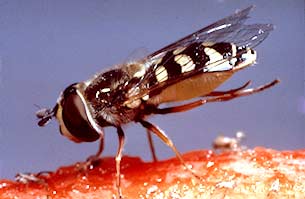Evaluating your Lacewing release
 |
Are the little buggers doing the job?How do you know the lacewing lacewings eggs you've released are controlling the pests in your garden? This is not a straight forward matter, since it is often very difficult to find the predators feeding on the pests, even if they are doing a good job at it. Let's take a look at the things you can observe and work forward from there. The lacewing eggs are milky white when laid and they turn a light green color as they develop. When they near hatching they become a medium to dark grey and finally turn white when the larva has emerged from the egg. You can watch the progress of development on the squares you've put out. Since the egg shell is left behind, you won't see any changes in the square itself, except for the subtle changes in the color of the eggs. Once the larva hatches, it begins looking for prey. It can travel over 100 feet before dying of starvation. When the lacewing larva senses an insect with its antennae, it attacks the prey with its sharp, needle-like mouthparts, impaling the victim and sucking out all its bodily fluids. If it is in, say, a colony of aphids, it will impale an aphid, suck it dry, then throw off the husk and impale another. It will continue to feed like this until it is swollen with food and finally sated. The larva then rests, often at a distance from the prey, until it has digested the food. When pest insects are common, the time spent resting is much greater than the time spent feeding, so it may not be easy to find the lacewing larva among the pest, even if the predator is feeding on that colony. Since it is very hard to find lacewing larvae, the best evaluation is to ask about the visible effects of the release a week or two after you put them out. Are pest numbers lower than expected? Is the trend of this infestation downward? Have no new pests shown up? If your answer to these questions is Yes, then you are probably getting effective control by the lacewings you released. If you answer No to any of these questions, you might consider spot treating with soap or oil to give the lacewing a chance to catch up, then re-evaluate in a week. |

